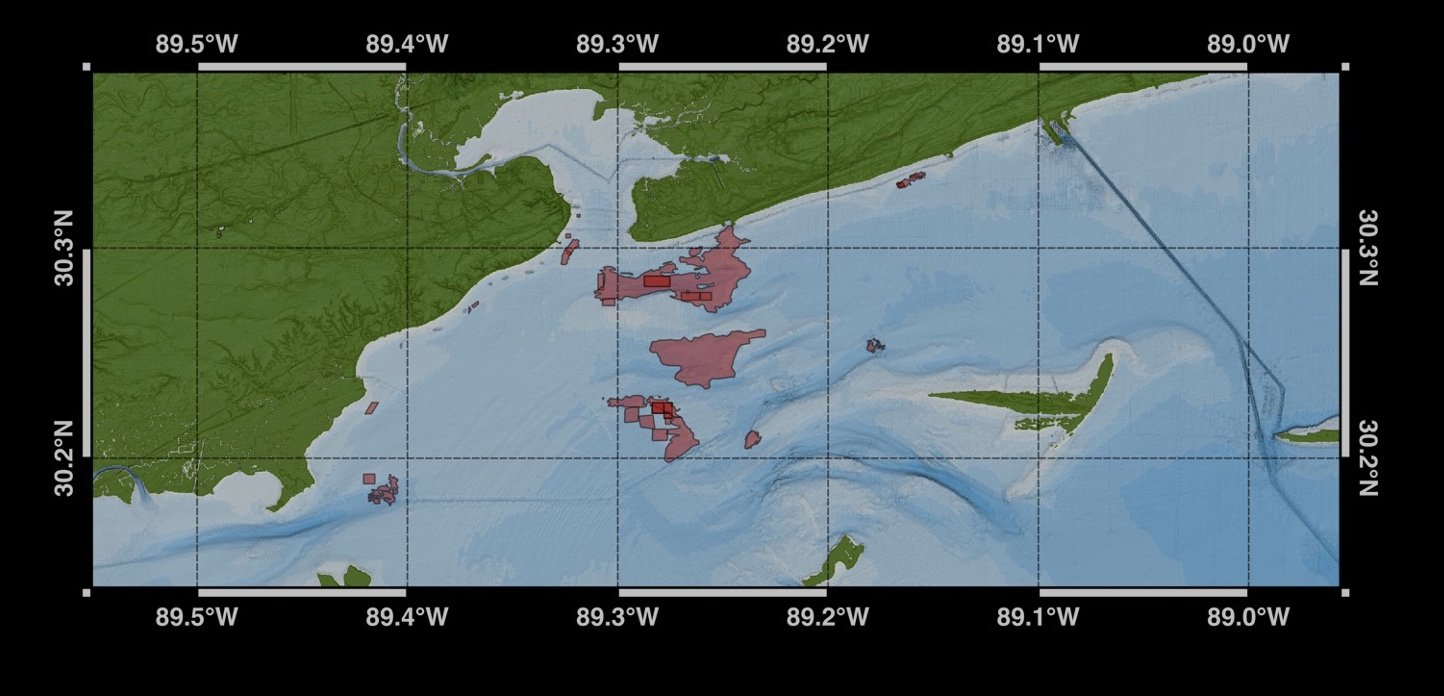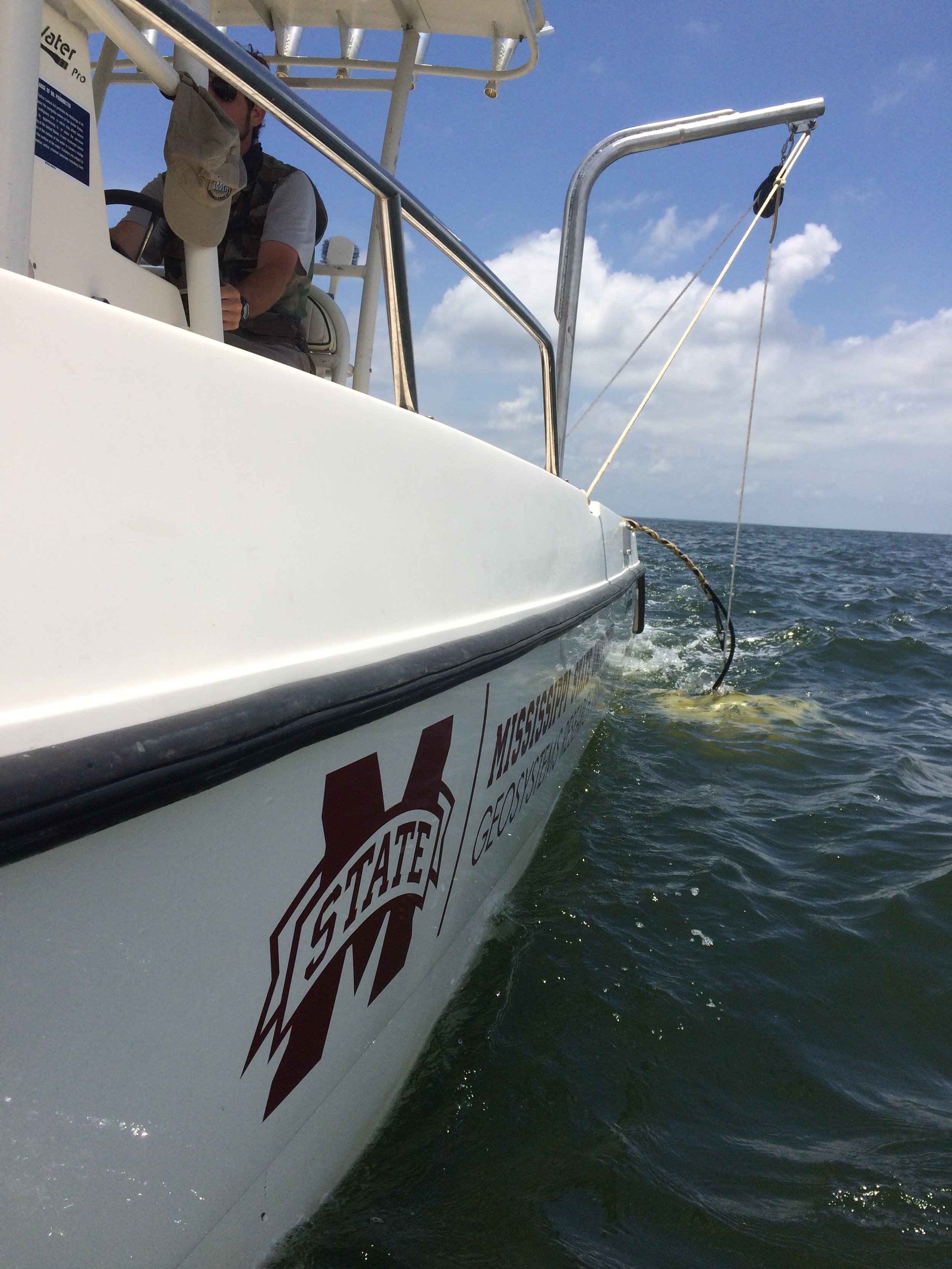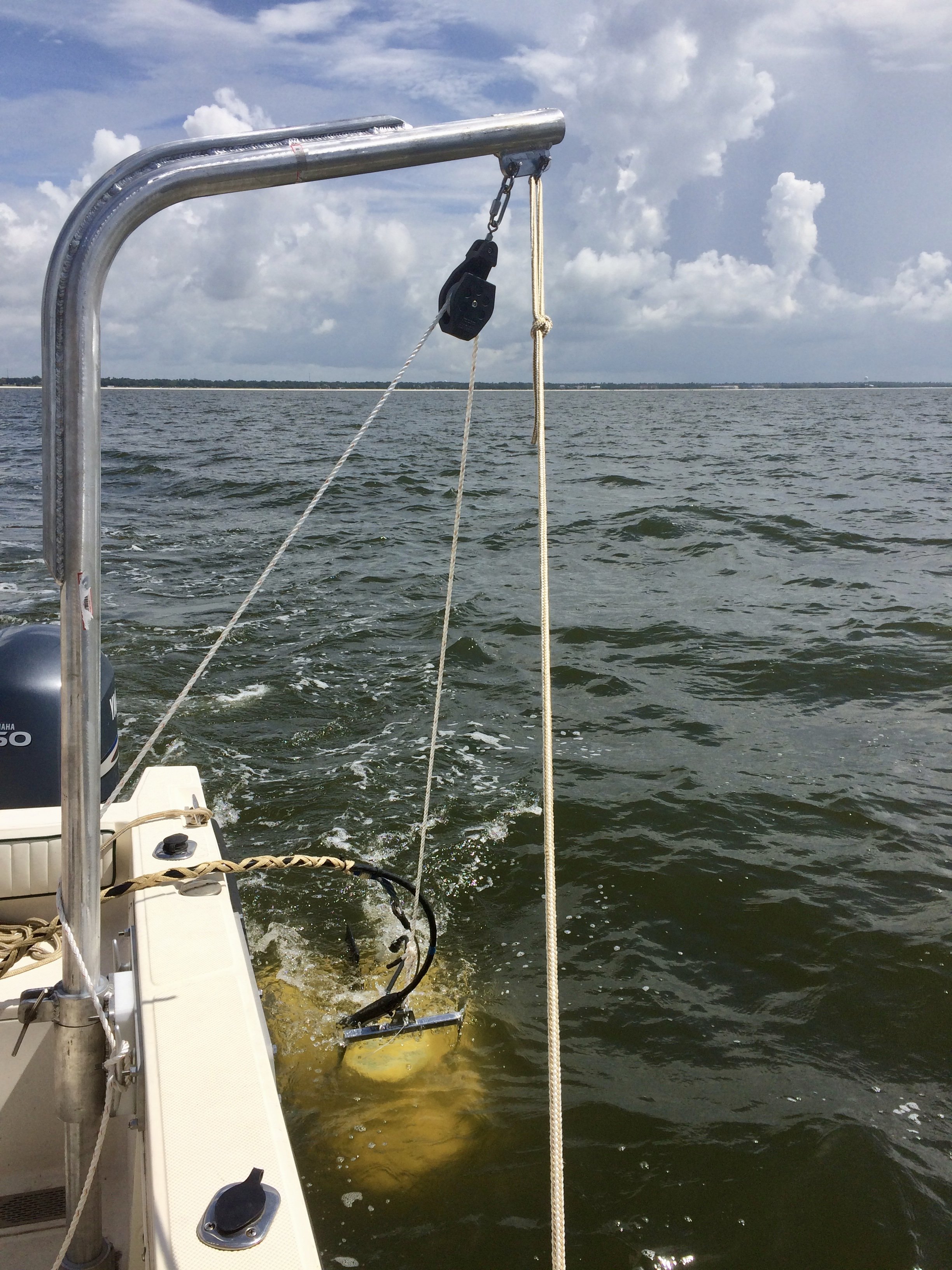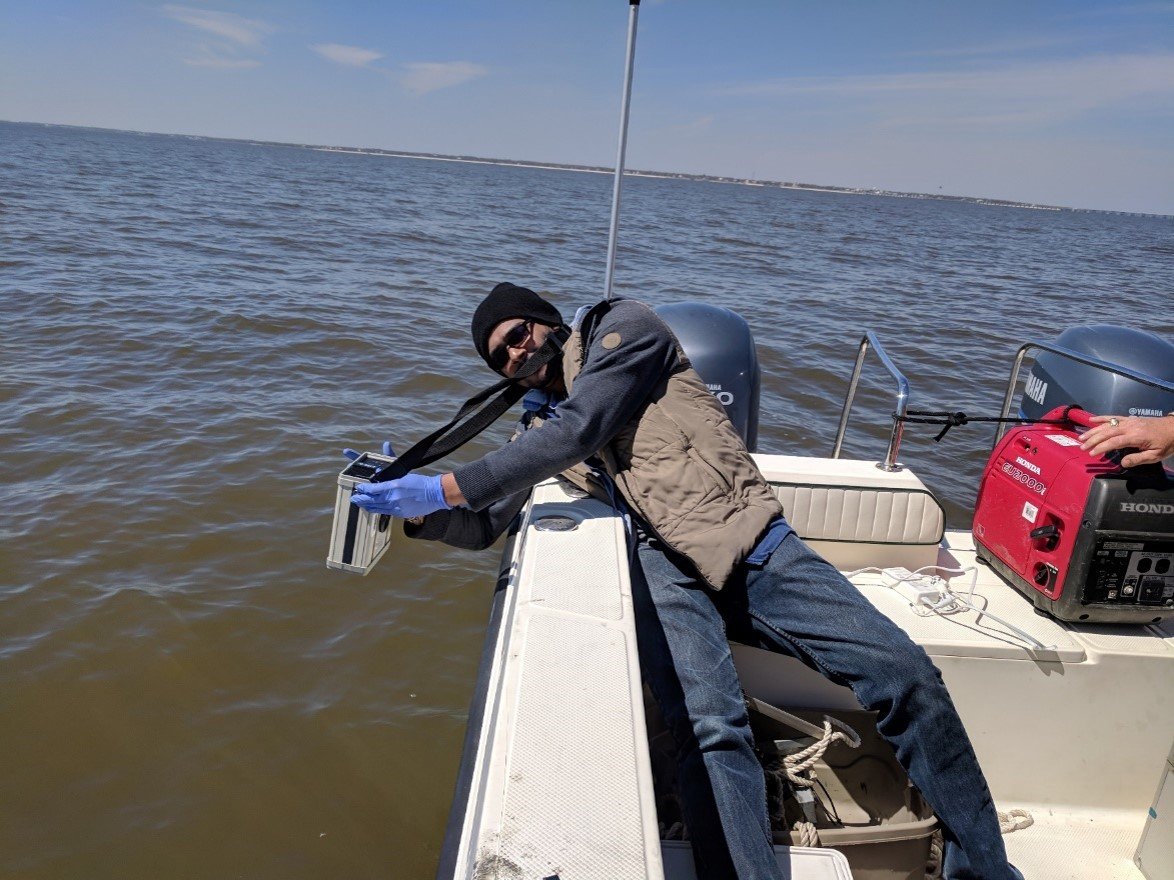Water Quality and Benthic Habitat Observations for Enhanced Understanding and Sustainable Management of Oyster Reefs in Mississippi Sound
Principal Investigators: Robert Moorhead, Adam Skarke, Padmanava Dash
Graduate Students: Daniel Adcock (MS Student), Saurav Silwal (PhD Student), Wondimagegn Beshah (PhD Student), Sudeera Wickramarathna (MS Student)
Undergraduate Students: Daniel McCraine
Award Amount: $625,000
Project Description
Goal:
Quantify the spatiotemporal variability of water quality and benthic habitat conditions at oyster reef sites in Mississippi Sound.
Why it is Important:
This work will enable the identification of suitable benthic habitats for reef restoration efforts and yield an improved understanding of the variable environmental stressors on oyster reef habitat quality and quantity. The collection of direct, remote, and autonomous vehicle observations will collectively contribute an expanded scientific understanding of oyster ecosystem resilience and improve the ability of the state of Mississippi to make timely and scientifically informed oyster reef management decisions.
Objectives:
Develop robust predictive algorithms to relate in situ water quality parameters at oyster reefs in Mississippi Sound to remotely sensed reflectance data collected with satellites and unmanned aerial systems.
Evaluate geological controls on the location of submarine groundwater discharge and resulting modification of water quality parameters proximal to oyster reefs in Mississippi Sound through the collection and synthesis of seismic and isotopic tracer data.
Create benthic habitat maps of seabed sedimentary characteristics proximal to oyster reefs in Mississippi Sound through the collection and synthesis of physical samples and acoustic reflexivity data.
Accomplishments:
Field data collected from 71 sites from the Henderson Point and Pass Christian Reefs in the Mississippi Sound via Unmanned Aerial Systems (UAS) and water samples.
Algorithms developed to quantify phycocyanin, colored dissolved organic matter, and suspended particulate matter using radiometer data.
Seismic profiling and isotopic tracers (radon-222) were used to investigate the spatial relationship between Pleistocene paleochannels, subsurface salinity, groundwater discharge at the seafloor, and commercially harvested oyster reefs at a study site in the western Mississippi Sound.
282 km of shallow subsurface seismic data was collected with a 2-16 kHz chirp sub-bottom profiling sonar. Combined with data previously collected from the United State Geological Survey, we were able to map the Pleistocene drainage network beneath the western Mississippi Sound.
Benthic habitat was acoustically mapped at selected locations proximal to the Henderson Point oyster reefs with a 990 kHz side scan sonar system. The resulting imagery was analyzed to characterize variability in seafloor reflectivity indicative of changes in the sedimentological properties of the substrate.
Project Outputs
-
Paul V, Sankar MS, Vattikuti S, Dash P, Arslan Z. 2020. Pullution assessment and land use cover influence on trace metal distribution in sediments from five aquatic systems in southern USA. Chemosphere 264: 128243. Link.
-
Skarke A, Adcock D, “Geologic control of submarine groundwater discharge in the Mississippi Sound”, American Geophysical Union Fall Meeting, San Francisco, California, December 9-13, 2019
Adcock D, Skarke A, “Characterizing the Pleistocene paleodrainage network of the western Mississippi Sound”, 2019 Meeting of the Mississippi Academy of Sciences, Hattiesburg, Mississippi, February 21-22, 2019
Beshah W, Dash P, Moorhead RJ, “Estimation of suspended particulate matter over the Henderson Point and Pass Christian Oyster Reefs, Mississippi using unmanned aerial systems imagery”, Mississippi Academy of Sciences, Hattiesburg, Mississippi, February 21-22, 2019
Dash P, Moorhead RJ, “Assessment of water quality using remote sensing technology over the Henderson Point and Pass Christian oyster reefs, Mississippi”, Mississippi Academy of Sciences, Hattiesburg, Mississippi, February 21-22, 2019
Hunt MP, Dash P, Wickramarathna S, Moorhead RJ, “Whether pigments other than chlorophyll a and phycocyanin significantly affect remote sensing reflectance?”, Mississippi Academy of Sciences, Hattiesburg, Mississippi, February 21-22, 2019
Sankar MS, Dash P, Yuehan LH, Moorhead, RJ “Dissolved organic matter biogeochemistry and its effect on ocean acidification over an oyster bed in the western Mississippi Sound, MS, USA”, Mississippi Academy of Sciences, Hattiesburg, Mississippi, February 21-22, 2019
Skarke A, Adcock D, “Geologic control of submarine groundwater discharge proximal to oyster reefs in Mississippi Sound”, 2019 Meeting of the Mississippi Academy of Sciences, Hattiesburg, Mississippi, February 21-22, 2019
Wickramarathna S, Dash P, Moorhead RJ, “Assessment of colored dissolved organic matter using unmanned aerial systems over the oyster reefs in the western Mississippi Sound”, Mississippi Academy of Sciences, Hattiesburg, Mississippi, February 21-22, 2019
Adcock D, Skarke A, “Characterizing the Pleistocene drainage network under the western Mississippi Sound, American Geophysical Union Fall Meeting, Washington DC, December 10-14, 2018
Beshah W, Dash P, Skarke A, Moorhead RJ, “An interactive map-based water quality visualization tool for the Gulf of Mexico”, Bays and Bayous Symposium, Mobile, Alabama, November 28-29, 2018
Sankar MS, Dash P, Yuehan LH, Arslan Z, Moorhead RJ, “Biogeochemical evaluation of dissolved organic matter and trace elements over an oyster bed in the western Mississippi Sound using multivariate statistics”, Bays and Bayous Symposium, Mobile, Alabama, November 28-29, 2018
Wickramarathna S, Dash P, Arslan Z, Moorhead RJ, “Water biogeochemistry affecting the oyster beds in the Western Mississippi Sound”, Bays and Bayous Symposium, Mobile, Alabama November 28-29, 2018
-
Robert Moorhead, Lee Hathcock. 2020. Multispectral reflectance imagery collected from an unmanned aerial system over oyster reefs in the Bay of St. Louis near Gulfport, Mississippi from 2018-03-13 to 2018-03-15. Distributed by: Gulf of Mexico Research Initiative Information and Data Cooperative (GRIIDC), Harte Research Institute, Texas A&M University–Corpus Christi. doi:10.7266/n7-ac34-g345
Robert Moorhead, Lee Hathcock. 2020. Multispectral reflectance imagery collected from an unmanned aerial system over oyster reefs in the Bay of St. Louis near Gulfport, Mississippi from 2018-05-07 to 2018-05-11. Distributed by: Gulf of Mexico Research Initiative Information and Data Cooperative (GRIIDC), Harte Research Institute, Texas A&M University–Corpus Christi. doi:10.7266/n7-gcx0-4e51
Robert Moorhead, Lee Hathcock. 2020. Multispectral reflectance imagery collected from an unmanned aerial system over oyster reefs in the Bay of St. Louis near Gulfport, Mississippi from 2018-06-18 to 2018-06-20. Distributed by: Gulf of Mexico Research Initiative Information and Data Cooperative (GRIIDC), Harte Research Institute, Texas A&M University–Corpus Christi. doi:10.7266/n7-9a8b-z205
Robert Moorhead, Lee Hathcock. 2020. Multispectral reflectance imagery collected from an unmanned aerial system over oyster reefs in the Bay of St. Louis near Gulfport, Mississippi from 2018-07-16 to 2018-07-20. Distributed by: Gulf of Mexico Research Initiative Information and Data Cooperative (GRIIDC), Harte Research Institute, Texas A&M University–Corpus Christi. doi:10.7266/n7-r300-zw38
Robert Moorhead, Lee Hathcock. 2020. Multispectral reflectance imagery collected from an unmanned aerial system over oyster reefs in the Bay of St. Louis near Gulfport, Mississippi from 2018-12-17 to 2018-12-18. Distributed by: Gulf of Mexico Research Initiative Information and Data Cooperative (GRIIDC), Harte Research Institute, Texas A&M University–Corpus Christi. doi:10.7266/n7-qrp5-6479
Robert Moorhead, Lee Hathcock. 2020. Headwall Photonics Nano-Hyperspec processed imagery collected from an unmanned aerial system over oyster reefs in the Bay of St. Louis near Gulfport, Mississippi from 2018-03-13 to 2018-03-15. Distributed by: Gulf of Mexico Research Initiative Information and Data Cooperative (GRIIDC), Harte Research Institute, Texas A&M University–Corpus Christi. doi:10.7266/S9SVSJ1V
Robert Moorhead, Lee Hathcock. 2020. Headwall Photonics Nano-Hyperspec processed imagery collected from an unmanned aerial system over oyster reefs in the Bay of St. Louis near Gulfport, Mississippi from 2018-05-07 to 2018-05-11. Distributed by: Gulf of Mexico Research Initiative Information and Data Cooperative (GRIIDC), Harte Research Institute, Texas A&M University–Corpus Christi. doi:10.7266/MW2PRASF
Robert Moorhead, Lee Hathcock. 2020. Headwall Photonics Nano-Hyperspec processed imagery collected from an unmanned aerial system over oyster reefs in the Bay of St. Louis near Gulfport, Mississippi from 2018-06-18 to 2018-06-20. Distributed by: Gulf of Mexico Research Initiative Information and Data Cooperative (GRIIDC), Harte Research Institute, Texas A&M University–Corpus Christi. doi:10.7266/NHHCYTDT
Robert Moorhead, Lee Hathcock. 2020. Headwall Photonics Nano-Hyperspec processed imagery collected from an unmanned aerial system over oyster reefs in the Bay of St. Louis near Gulfport, Mississippi from 2018-07-16 to 2018-07-20. Distributed by: Gulf of Mexico Research Initiative Information and Data Cooperative (GRIIDC), Harte Research Institute, Texas A&M University–Corpus Christi. doi:10.7266/BM0G0C4S
Robert Moorhead, Lee Hathcock. 2020. Headwall Photonics Nano-Hyperspec processed imagery collected from an unmanned aerial system over oyster reefs in the Bay of St. Louis near Gulfport, Mississippi from 2018-12-17 to 2018-12-18. Distributed by: Gulf of Mexico Research Initiative Information and Data Cooperative (GRIIDC), Harte Research Institute, Texas A&M University–Corpus Christi. doi:10.7266/SDX8GEZY
Robert Moorhead, Lee Hathcock. 2020. Multispectral reflectance imagery collected from an unmanned aerial system over oyster reefs in the Bay of St. Louis near Gulfport, Mississippi from 2019-06-15 to 2019-06-19. Distributed by: Gulf of Mexico Research Initiative Information and Data Cooperative (GRIIDC), Harte Research Institute, Texas A&M University–Corpus Christi. doi:10.7266/0408928T
Robert Moorhead, Lee Hathcock. 2020. Multispectral reflectance imagery collected from an unmanned aerial system over oyster reefs in the Bay of St. Louis near Gulfport, Mississippi from 2019-07-29 to 2019-08-02. Distributed by: Gulf of Mexico Research Initiative Information and Data Cooperative (GRIIDC), Harte Research Institute, Texas A&M University–Corpus Christi. doi:10.7266/RS8EK53Z
Robert Moorhead, Lee Hathcock. 2020. Headwall Photonics Nano-Hyperspec processed imagery collected from an unmanned aerial system over oyster reefs in the Bay of St. Louis near Gulfport, Mississippi from 2019-06-15 to 2019-06-19. Distributed by: Gulf of Mexico Research Initiative Information and Data Cooperative (GRIIDC), Harte Research Institute, Texas A&M University–Corpus Christi. doi:10.7266/AJX6GZ12
Robert Moorhead, Lee Hathcock. 2020. Headwall Photonics Nano-Hyperspec processed imagery collected from an unmanned aerial system over oyster reefs in the Bay of St. Louis near Gulfport, Mississippi from 2019-07-29 to 2019-08-02. Distributed by: Gulf of Mexico Research Initiative Information and Data Cooperative (GRIIDC), Harte Research Institute, Texas A&M University–Corpus Christi. doi:10.7266/98DZGRKD
Skarke, Adam and Daniel Adcock. 2021. Seismic profiles of subsurface stratigraphy in the Mississippi Sound aboard R/V Sound Surveyor, 2018-06-12 to 2018-11-08. Distributed by: Gulf of Mexico Research Initiative Information and Data Cooperative (GRIIDC), Harte Research Institute, Texas A&M University–Corpus Christi. doi:10.7266/2VYKF6TS





